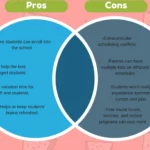As the debate over year-round schooling continues, many parents and educators find themselves perplexed by the pros and cons of this alternative education model. While some argue that year-round schooling provides academic, financial, and social benefits, others point to its academic drawbacks, financial drawbacks, and social drawbacks. In this article, we will explore the advantages and disadvantages of year-round schooling, compare it to traditional schooling, and consider the impact on summer vacation. Join us as we delve into this complex and important topic.
Contents
Advantages of Year-Round Schooling

Year-round schooling has several advantages over traditional schooling. One of the main academic benefits is that students are less likely to forget the material they learned during the school year because of the shorter breaks throughout the year. Additionally, year-round schooling can improve student achievement, especially for those who struggle with learning disabilities. Financially, year-round schooling can be more cost-effective because it allows for more efficient use of school facilities and resources. Socially, year-round schooling can provide more opportunities for extracurricular activities and increased family time. Year-round schooling offers several advantages that can benefit students, families, and schools. For more information on different types of colleges, check out our article on different types of colleges.
Academic Benefits
Year-round schooling has several academic benefits that make it an attractive option for many parents and educators. One of the main advantages is that it can help students retain the information they learn in class. With shorter breaks between terms, students are less likely to forget what they learned in the previous term. This is especially important for subjects like math and science, where concepts build on each other from one grade to the next. Additionally, year-round schooling can help improve student achievement. Studies have shown that students in year-round schools have higher test scores and are more likely to graduate on time than their peers in traditional schools.
Another academic benefit of year-round schooling is that it provides more opportunities for remediation and enrichment. With shorter breaks between terms, teachers can identify areas where students need extra help and provide targeted interventions to help them catch up. On the other hand, students who are excelling can take advantage of optional classes and workshops during the breaks to further their learning. This flexibility can help ensure that all students are challenged and engaged in their education.
Finally, year-round schooling can help students transition to the real world after graduation. By providing more frequent breaks throughout the year, students have more opportunities to participate in internships, summer jobs, and other activities that can give them real-world experience and help them build their resumes. This can be especially valuable for students who are interested in pursuing careers in fields like engineering, science, or business.
The academic benefits of year-round schooling are numerous and can make a real difference in the lives of students. From better retention of information to increased achievement and more opportunities for enrichment and remediation, year-round schooling is a compelling option for many families and educators.
Financial Benefits
Year-round schooling can provide several financial benefits for both schools and families. One of the most significant financial benefits is that it can save money on school facilities and maintenance. With year-round schooling, schools can operate on a rotating schedule, allowing them to accommodate more students in the same facility. This eliminates the need to build new schools or expand existing ones, which can be a significant cost-saving measure. Additionally, schools can save money on maintenance costs since the facilities are being used more efficiently.
Another financial benefit of year-round schooling is that it can reduce the need for summer school programs. Many students struggle to retain information over the long summer break, leading to the need for summer school programs. However, with year-round schooling, students have more frequent breaks throughout the year, reducing the need for summer school. This can save families money on summer school tuition and can save schools money on summer school staffing and facilities.
Finally, year-round schooling can benefit families financially by reducing the need for expensive summer childcare. With a shorter summer break, families have less time to fill with childcare, which can be expensive. Additionally, since students have more frequent breaks throughout the year, families can plan for shorter, less expensive vacations throughout the year instead of one long, expensive summer vacation.
The financial benefits of year-round schooling can be significant for schools and families, providing cost-saving measures that can benefit everyone involved.
Year-round schooling has several social benefits that should be considered. One of the advantages is that it allows for greater flexibility in scheduling family vacations. Students can take time off during the school year, rather than being limited to the traditional summer break. This can be especially beneficial for families with working parents who may not be able to take off during traditional school breaks.
Another social benefit of year-round schooling is that it can reduce the risk of student boredom and apathy. Because students have more frequent breaks, they are less likely to become disengaged from their studies. This can lead to greater enthusiasm for learning and a more positive attitude towards school.
Year-round schooling can also help to reduce the achievement gap between students of different socioeconomic backgrounds. By providing opportunities for extended learning time and enrichment activities during the school year, students who may not have access to these resources outside of school can gain an academic advantage. This can help to level the playing field and ensure that all students have the opportunity to succeed.
Additionally, year-round schooling can have a positive impact on the community as a whole. By reducing the number of students who are not engaged in structured activities during the summer months, it can help to reduce crime and other negative social behaviors. It can also provide opportunities for students to participate in community service and other civic activities, which can help to build a sense of community and social responsibility.
The social benefits of year-round schooling are significant and should be considered when evaluating this alternative to traditional schooling. While there are certainly some challenges and drawbacks associated with this approach, the potential benefits are worth exploring and could have a positive impact on students and communities alike.
Disadvantages of Year-Round Schooling

Year-round schooling has its disadvantages as well. One major drawback is the lack of a long summer break, which can be a source of stress for some students who need a break from school. Year-round schooling can make it difficult for families to plan vacations and other summer activities. Another disadvantage is that students and teachers may experience burnout from not having a long enough break between school terms. Finally, year-round schooling can be more expensive for schools, as they need to provide additional services such as cafeteria and custodial services during the breaks.
Academic Drawbacks
One of the main academic drawbacks of year-round schooling is that it can be difficult for students to maintain focus and motivation throughout the year. With shorter breaks, there is less time for students to recharge and relax, which can lead to burnout and decreased academic performance. Additionally, year-round schooling can disrupt the continuity of instruction, as students may forget material covered earlier in the year during the longer breaks.
Another issue is the impact on extracurricular activities. Year-round schooling can make it difficult for students to participate in summer programs, such as sports teams or music camps, that are often scheduled during the traditional summer break. This can be especially problematic for students who rely on summer programs for scholarships or to enhance their college applications.
Year-round schooling can also create scheduling conflicts for families. With different schools on different schedules, families may struggle to find childcare options or to coordinate vacations. This can create additional stress for students and parents alike, which can negatively impact academic performance.
While year-round schooling may offer some academic benefits, it is important to consider the potential drawbacks as well. Schools and families should carefully weigh the pros and cons before deciding whether year-round schooling is the right choice for their students.
Financial Drawbacks
When it comes to financial drawbacks of year-round schooling, there are several factors to consider. One of the biggest disadvantages is the cost of implementing a year-round schedule. According to Pearson, the cost of converting a traditional school to a year-round schedule can range from $130,000 to $500,000 per school.
Another financial drawback is the cost of running the school year-round. Since the school is open for more days, there are additional expenses such as electricity, air conditioning, and maintenance. Teachers who work year-round may require higher salaries, which can add to the school’s expenses.
Year-round schooling can have an impact on families’ finances. For instance, parents may have to pay for child care during the frequent breaks throughout the year. This can be especially burdensome for low-income families who cannot afford to pay for additional child care.
While year-round schooling has its advantages, it is important to consider the financial drawbacks before making a decision. The cost of converting to a year-round schedule and running the school year-round can be significant, and families may face additional expenses for child care during the frequent breaks.
Some of the social drawbacks of year-round schooling include the impact on family life and community events. Year-round schooling can make it difficult for families to plan vacations or other activities due to the scattered breaks throughout the year. Additionally, students may miss out on traditional summer activities such as summer camps or jobs, which can impact their social development and ability to gain work experience. Year-round schooling can also lead to a lack of continuity in extracurricular activities and sports teams, as students may be on different schedules and unable to participate in the same events. These social drawbacks can cause stress and frustration for students, families, and community members alike. It’s important to consider the impact on social development and community involvement when evaluating the pros and cons of year-round schooling.
Year-Round Schooling vs. Traditional Schooling
When it comes to year-round schooling vs. traditional schooling, there are several factors to consider. One major difference is the schedule, with year-round schools typically offering shorter breaks throughout the year instead of a long summer vacation. This can help prevent student learning loss during the summer months, but it can also lead to teacher and student burnout. Additionally, the impact on summer vacation is a consideration for families who may have difficulty scheduling vacations or other activities during the shorter breaks. While there are pros and cons to both approaches, it ultimately comes down to what works best for each individual student and their family.
Comparison of Schedules
Year-round schooling and traditional schooling have different schedules. In year-round schooling, students attend classes for a set number of days and then have a break for a few weeks before starting again. This cycle repeats throughout the year. In contrast, traditional schooling has a long summer break and shorter breaks during the school year.
One advantage of the year-round schedule is that students have more frequent breaks, which can help prevent burnout and increase retention of material. Additionally, students who struggle with traditional long-term learning may benefit from the shorter, more frequent sessions of learning.
On the other hand, traditional schooling schedules may allow for more time for extracurricular activities, such as summer camps and internships. It also allows families to plan vacations during the summer months, which may not be possible with year-round schooling.
Another consideration is the impact on teachers. Year-round schooling may result in a more demanding workload, as teachers are required to teach more days throughout the year. This can lead to burnout and a higher turnover rate. In contrast, traditional schooling schedules may allow for more time for professional development and planning.
Ultimately, the choice between year-round schooling and traditional schooling schedules depends on individual preferences and priorities. It is important to weigh the benefits and drawbacks of each option before making a decision.
Teacher and Student Burnout
Teacher Burnout: One of the major drawbacks of year-round schooling is the potential for teacher burnout. Teachers are already under a great deal of stress, and year-round schooling can add to this stress. With shorter breaks throughout the year, teachers may not have enough time to fully recharge and may become overwhelmed. Additionally, the lack of a long summer break can make it difficult for teachers to pursue additional education or training during the summer months.
Student Burnout: Year-round schooling can also lead to student burnout. With shorter breaks throughout the year, students may not have enough time to fully relax and recharge. This can lead to decreased motivation and increased stress levels. Additionally, students may feel like they are constantly in school, which can lead to a lack of enthusiasm for learning.
Comparison: When comparing year-round schooling to traditional schooling, it is important to consider the potential for teacher and student burnout. While year-round schooling can provide more instructional time, it can also lead to increased stress levels for both teachers and students. Traditional schooling, on the other hand, provides a longer summer break that allows for more time to recharge and pursue other interests.
To summarize, year-round schooling has both advantages and disadvantages. While it can provide more instructional time and help prevent summer learning loss, it can also lead to teacher and student burnout. When considering year-round schooling, it is important to weigh these factors and determine what will work best for each individual student and teacher.
Impact on Summer Vacation
Year-round schooling has a significant impact on summer vacation. With year-round schooling, students have shorter breaks throughout the year instead of a long summer vacation. This means that families who are used to taking vacations during the summer months may have to adjust their plans. Many summer programs and camps are structured around the traditional school calendar, so students in year-round programs may miss out on these opportunities or have to find alternatives.
On the other hand, supporters of year-round schooling argue that the shorter breaks allow for more frequent and flexible opportunities for travel and family time. They also point out that students in traditional schools often experience a “summer slide” where they lose academic progress over the long break, whereas year-round schooling can help prevent this loss.
Additionally, the impact on summer employment should also be considered. Many teenagers rely on summer jobs to earn money, and year-round schooling could interfere with this. However, it could also provide more opportunities for part-time jobs throughout the year.
The impact on summer vacation is a significant consideration when deciding whether to implement year-round schooling. Families and students who value traditional summer activities may be resistant to the change, while those who prioritize academic progress and flexibility may see it as a positive shift.
Conclusion
After weighing the pros and cons of year-round schooling, it is clear that this type of schedule has both advantages and disadvantages. While year-round schooling can provide academic, financial, and social benefits for students, there are also drawbacks to consider, including academic setbacks and financial burdens. Additionally, the impact on summer vacation and teacher and student burnout should not be overlooked.
When comparing year-round schooling to traditional schooling, it is important to consider the differences in schedules and the potential for burnout. While year-round schooling can help to prevent summer learning loss and provide more consistent education throughout the year, it may not be the best fit for all students and families.
Ultimately, the decision to implement year-round schooling should be based on the specific needs and circumstances of each school and community. It is important to carefully weigh the potential benefits and drawbacks and consider the impact on students, teachers, and families. With careful planning and consideration, year-round schooling can be a successful option for improving student achievement and providing a more consistent and well-rounded education.
Frequently Asked Questions
FAQs
1. What is year-round schooling?
Year-round schooling is a system where schools operate on a schedule that involves shorter breaks throughout the year, rather than one long summer break.
2. What are the academic benefits of year-round schooling?
Academic benefits of year-round schooling include reducing the amount of time students spend away from learning, increasing retention of information, and providing more opportunities for remediation and enrichment.
3. What are the financial benefits of year-round schooling?
Financial benefits of year-round schooling include reducing the costs associated with summer programs and activities, increasing the use of school facilities, and providing opportunities for year-round employment for staff.
4. What are the social benefits of year-round schooling?
Social benefits of year-round schooling include providing more opportunities for community involvement, reducing the negative effects of summer learning loss, and helping to alleviate child care issues for working parents.
5. What are the academic drawbacks of year-round schooling?
Academic drawbacks of year-round schooling include increased teacher and student burnout, the potential for reduced instructional time, and the potential for increased disruption to learning due to frequent breaks.
6. What are the financial drawbacks of year-round schooling?
Financial drawbacks of year-round schooling include increased costs associated with air conditioning and other utilities during the summer months, the cost of implementing the year-round schedule, and potential loss of revenue from summer programs.
7. What are the social drawbacks of year-round schooling?
Social drawbacks of year-round schooling include the potential for reduced family time during the year, potential challenges with planning vacations or family events, and the potential for negative effects on the tourism industry.
8. How does year-round schooling compare to traditional schooling?
Year-round schooling differs from traditional schooling in that it operates on a schedule with shorter breaks throughout the year, rather than one long summer break.
9. What are the potential impacts of year-round schooling on teacher and student burnout?
The potential impacts of year-round schooling on teacher and student burnout include increased stress and fatigue due to the lack of a long summer break, reduced opportunities for rest and relaxation, and increased workload due to the need to provide continuous instruction throughout the year.
10. How does year-round schooling impact summer vacation?
Year-round schooling impacts summer vacation by eliminating the traditional long break and replacing it with shorter breaks throughout the year.







